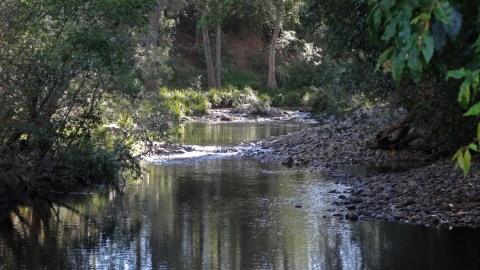Aquatic Ecosystems Task Group (2012) Aquatic ecosystems toolkit. Module 2. Interim Australian national aquatic ecosystem classification framework. Australian Government Department of Sustainability, Environment, Water, Population and Communities, Canberra. Viewed 5 August 2014, http://www.environment.gov.au/system/files/resources/08bfcf1a-0030- 45e0-8553-a0d58b36ee03/files/ae-toolkit-module-2-anae-classification.pdf.
Barrett DJ, Couch CA, Metcalfe DJ, Lytton L, Adhikary DP and Schmidt RK (2013) Methodology for bioregional assessments of the impacts of coal seam gas and coal mining development on water resources. A report prepared for the Independent Expert Scientific Committee on Coal Seam Gas and Large Coal Mining Development through the Department of the Environment. Department of the Environment, Australia. Viewed 14 May 2015, http://www.iesc.environment.gov.au/publications/methodology-bioregional-assessments-impacts-coal-seam-gas-and-coal-mining-development-water.
Bureau of Meteorology (2012) Australian Hydrological Geospatial Fabric (Geofabric): Product Guide, Version 2.1 November 2012. Bureau of Meteorology, Canberra. Viewed 20 November 2014, http://www.bom.gov.au/water/geofabric/index.shtml.
Bureau of Meteorology (2013) Guide to environmental accounting in Australia. Environmental Information Programme Publication Series no. 3. Bureau of Meteorology, Canberra, Australia. Viewed 5 August 2015, http://www.bom.gov.au/environment/doc/environmental_accounting_guide.pdf.
Bureau of Meteorology (2014) About the groundwater dependent ecosystems atlas. Viewed 14 October 2014, http://www.bom.gov.au/water/groundwater/gde/.
Crosbie R, Peeters L and Carey H (2016) Groundwater modelling. Submethodology M07 from the Bioregional Assessment Technical Programme. Department of the Environment and Energy, Bureau of Meteorology, CSIRO and Geoscience Australia, Australia. http://data.bioregionalassessments.gov.au/submethodology/M07.
Department of Agriculture (2010) The Australian land use and management (ALUM) classification, version 7, May 2010. Department of Agriculture, Canberra. Viewed 14 October 2014, http://www.daff.gov.au/abares/aclump/pages/land-use/alum-classification-version-7-may-2010/default.aspx.
Department of the Environment (2014) Ramsar wetland type classification. Department of the Environment, Canberra. Viewed 17 July 2014, http://www.environment.gov.au/topics/water/water-our-environment/wetlands/ramsar-convention-wetlands/ramsar-wetland-type.
Department of Environment and Heritage Protection (2015) WetlandInfo. Queensland Department of Environment and Heritage Protection. Viewed 16 April 2015, http://wetlandinfo.ehp.qld.gov.au/wetlands/ecology/aquatic-ecosystems-natural/.
Ford JH, Hayes KR, Henderson BL, Lewis S and Baker PA (2016) Systematic analysis of water-related hazards associated with coal resource development. Submethodology M11 from the Bioregional Assessment Technical Programme. Department of the Environment and Energy, Bureau of Meteorology, CSIRO and Geoscience Australia, Australia. http://data.bioregionalassessments.gov.au/submethodology/M11.
Henderson B, Hayes KR, O'Grady A, Mount R, Lewis S, Schmidt RK, Dambacher J, Barry S, Holland K and Raiber M (2016) Developing the conceptual model of causal pathways. Submethodology M05 from the Bioregional Assessment Technical Programme. Department of the Environment and Energy, Bureau of Meteorology, CSIRO and Geoscience Australia, Australia. http://data.bioregionalassessments.gov.au/submethodology/M05.
Leathwick JR, Snelder T, Chadderton W, Elith J, Julian K and Ferrier S (2011) Use of generalised dissimilarity modelling to improve the biological discrimination of river and stream classifications. Freshwater Biology 56(1): 21-38.
Lewis S (2014) Developing a coal resource development pathway. A submethodology from the Bioregional Assessment Technical Programme. Department of the Environment, Bureau of Meteorology, CSIRO and Geoscience Australia, Australia. Viewed 17 February 2016, http://data.bioregionalassessments.gov.au/submethodology/M04.
Linke S, Turak E and Nel J (2011) Freshwater conservation planning: the case for systematic approaches. Freshwater Biology 56(1), 6–20. DOI: 10.1111/j.1365-2427.2010.02456.x.
Linke S, Watts ME and Possingham HP (2007) Muddy waters: modifying reserve design algorithms for riverine landscapes. In: Oxley L and Kulasiri D (eds) MODSIM 2007 International Congress on Modelling and Simulation. Modelling and Simulation Society of Australia and New Zealand, December 2007, Canterbury, NZ.
Moilanen A, Leathwick J and Elith J (2008) A method for spatial freshwater conservation prioritization. Freshwater Biology 53(3), 577–592. DOI: 10.1111/j.1365-2427.2007.01906.x.
Mount RE, Mitchell PJ, Macfarlane C, Marston FM, McNamara JM, Raisbeck-Brown N, O'Grady AP, Moran BT and Wang J (2015) Compiling water-dependent assets. A submethodology from the Bioregional Assessment Technical Programme. Department of the Environment, Bureau of Meteorology, CSIRO and Geoscience Australia, Australia. Viewed 17 February 2016, http://data.bioregionalassessments.gov.au/submethodology/M02.
O’Grady AP, McNamara J, Welsh WD, Holland KL, Aryal SK, Mount RE and Marston FM (2015) Description of the water-dependent asset register for the Namoi subregion. Product 1.3 for the Namoi subregion from the Northern Inland Catchments Bioregional Assessment. Department of the Environment, Bureau of Meteorology, CSIRO and Geoscience Australia, Australia. Viewed 13 April 2016, http://data.bioregionalassessments.gov.au/product/NIC/NAM/1.3.
Peeters L, Pagendam D, Gao L, Hosack G, Jiang W and Henderson B (2016) Propagating uncertainty through models. Submethodology M09 from the Bioregional Assessment Technical Programme. Department of the Environment and Energy, Bureau of Meteorology, CSIRO and Geoscience Australia, Australia. http://data.bioregionalassessments.gov.au/submethodology/M09.
Pfafstetter O (1989) Classification of hydrographic basins: coding methodology. Unpublished manuscript. Departamento Nacional de Obras de Saneamento, 18 August 1989, Rio de Janeiro. Available from: JP Verdin, US Geological Survey, EROS Data Center, Sioux Falls, SD.
River Styles (2014) The River Styles framework. Viewed 17 July 2014, http://www.riverstyles.com/outline.php.
SEWPaC (2012) Interim Biogeographic Regionalisation for Australia (IBRA), Version 7. Australian Government Department of Sustainability Environment Water Population and Communities, Canberra.
Stevens DL and Olsen AR (2004) Spatially balanced sampling of natural resources. Journal of the American Statistical Association 99, 262–278.
Turak E and Koop K (2008) Multi-attribute ecological river typology for assessing ecological condition and conservation planning. Hydrobiologia 603, 83–104.
United Nations, European Commission, Food and Agriculture Organization of the United Nations, Organisation for Economic Co-Operation and Development and World Bank Group (2014) System of environmental-economic accounting 2012: experimental ecosystem accounting. United Nations, New York. Viewed 16 April 2015, http://unstats.un.org/unsd/envaccounting/seeaRev/eea_final_en.pdf.
Viney N (2016) Surface water modelling. Submethodology M06 from the Bioregional Assessment Technical Programme. Department of the Environment and Energy, Bureau of Meteorology, CSIRO and Geoscience Australia, Australia. http://data.bioregionalassessments.gov.au/submethodology/M06.
Welsh W, Hodgkinson J, Strand J, Northey J, Aryal S, O’Grady A, Slatter E, Herron N, Pinetown K, Carey H, Yates G, Raisbeck-Brown N and Lewis S (2014) Context statement for the Namoi subregion. Product 1.1 from the Northern Inland Catchments Bioregional Assessment. Department of the Environment, Bureau of Meteorology, CSIRO and Geoscience Australia, Australia. Viewed 13 April 2016, http://data.bioregionalassessments.gov.au/product/NIC/NAM/1.1.

METHODOLOGY FINALISATION DATE
- 1 Background and context
- 2 Defining receptors
- 3 Assigning receptors
- 3.1 Overview of process for assigning receptors
- 3.2 Landscape classification
- 3.3 Process for assigning receptors across the landscape
- 4 Developing a receptor register
- References
- Datasets
- Glossary
- Citation
- Acknowledgements
- Contributors to the Technical Programme
- About this submethodology
